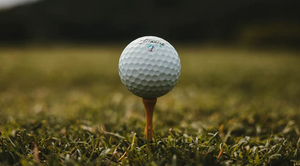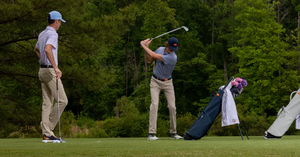What Is a Blade Putter?
Depending on who you ask, there are two or three different kinds of putters: the blade putter, the mallet putter, and the modern mallet. Here, we're going to be talking all about the blade putter. Its pros, its cons, how it compares to the mallet, and - perhaps most importantly - who each putter is best suited for.
The putter options for golfers have exploded in recent years, so follow our guide to pick the best putter for your game.
Pros of a Blade Putter
Blade putters are the most popular type of this club on the market. That isn't by accident. There are a number of advantages to blade putters over their mallet competitors that make them a natural choice for many players.
Works Well on Fast Greens
The primary advantage of using the blade style is its effectiveness on fast greens. Inexperienced golfers fear fast greens in part because they make putting so tricky. The slower read the stimpmeter gives a green, the easier it is to nail that final shot in a single put.
The blade putter's precision and control will help you succeed even on the fastest greens.
Helpful for Arc Stroke Putters
Blade putters have thin, flat heads with rounded soles that resemble shaving blades, hence the name. The stainless steel head has a nice weight to it, and the overall design of the club gives it superior control.
If you have an arc to your stroke, the blade putter will help you keep it in check so you can make every shot.
Great for Close-range Shots
Blade putters may not be the best for long-range putting. Put in a more positive way, if you're between 5 and 10 feet of the hole, you're going to make that shot. The precise strike of the steelhead on the ball sends it in an unerring line toward your intended destination.
Helps Improve your Accuracy
It's not just that this type of club is accurate. It will help promote accuracy in your strokes the more you use it. It's like putting on training wheels when you need a guiding hand.
Cons of a Blade Putter
The pros of the blade far outweigh the cons, but let's discuss a few cons for balance.
Not as Forgiving as a Mallet
The precision and accuracy of the blade indeed make it great for close-range shots, inexperienced golfers, and those looking to improve their accuracy. But the very accuracy that the blade helps golfers achieve can also prove a disadvantage.
Because the blade is so direct and instantaneous when it connects to the ball, there isn't as much forgiveness as there is with a mallet putter. Mallets will help correct your more inaccurate strokes in a way that blades won't.
Harder to Line
A consequence of the lack of forgiveness is greater difficulty in lining strokes. A blade's putter alignment line will generally be around an inch long, making it harder to line up shots.
Not as Helpful 10 feet+ from the Hole
If you're trying to make a hole 10 or more feet from you, we recommend using a mallet putter. These clubs are better suited to long-range, ambling shots.
But one upside to walking further distances is that you'll certainly get more of a workout. One 2016 study found that playing golf had measurable positive effects on physical health, mental health, and overall well-being. So if you keep landing shots far away from the hole, consider that a different kind of success!
Blade Putter vs. Mallet Putter
Mallet putters differ from blade putters in these ways:
- They have larger heads
- They're slightly heavier
- They come in a wide range of shapes and styles
- The weight concentrates away from the clubface
In concert, these design differences have several impacts on the club's functionality. Many golfers report that mallet putters have a larger sweet spot, making them ideal for novices just getting into the swing of putting. Since most of the weight is concentrated at the back of the club head, they provide much more forgiveness.
The “forgiveness” that mallet putters offer comes in the form of alignment aid. If you're a way out from the hole or are a bit shaky on your putting form, mallet putters will help shape up your stroke.
Note that not all mallet putters are heavier than blade putters. There is a vast range of mallet putters on the market now, so make sure to measure and weigh them before you use them. Their weight could truly impact your game, depending on your golf level.
Who Are Mallet Putters Best Suited To?
If you're a beginning golfer, you should start out using a mallet putter. They're great clubs for folks looking to improve their short game, gain confidence, work on their alignment, and need a little forgiveness. They're also ideal for:
- High handicap golfers
- Golfers who have straight-through and straight-back swings
- Golfers who excel with every club but the putter
The key to picking the right putter also comes down to whether you want to use a mid-mallet or a full mallet putter. A side-by-side comparison reveals a drastically different shape, which does lead to real changes on the green. Full mallets have the biggest head size of any putter and are the most weighty. Mid-mallets are slightly less large and weighty, putting them more in line with blade putters.
Notable Players who use mallet putters
Tiger Woods used a blade putter throughout the entirety of his career. According to a 2021 poll, Woods showed the highest favorability ranking among all high-profile golfers throughout history, topping the list at 70%. Almost ¾ of all golf fans can't be wrong about the pros of mallet putters!
Other pro golfers who use mallet putters include:
- Tommy Fleetwood
- Jordan Spieth
- Matt Fitzpatrick
- Collin Morikawa
- Cameron Smith
Tommy Fleetwood won the European Tour six times, and used a mallet putter each time. Jordan Spieth is a former world number one golfer per the Official World Golf Ranking, and he's used mallet putters before.
Frequently Asked Questions
What Is a Blade Putter Used For?
Golfers use blade putters and mallet putters for the same purpose: putting the ball into the hole at close range. In contrast to mallet putters, blade putters are better suited to close-range strokes and on fast greens.
Are Blade Putters Good for Beginners?
Blade putters are suitable for beginners in some senses - and bad in others. They're good in that they help golfers conquer fast greens and can help improve accuracy. On the flip side, they have less forgiveness than mallet putters, making them better for beginners learning to play.
Just Starting Out? Shop Stitch Golf For Your Golf Accessories & Apparel!
If you're beginning to assemble a kit and build up your game, visit Stitch Golf's online store. Stitch Golf carries all the essential accessories and apparel you'll need to complete your kit, from golf bags, polos, and hats, to knit headcovers, towels, and even coozies. Shop today to find everything you need - and didn't know you needed.



